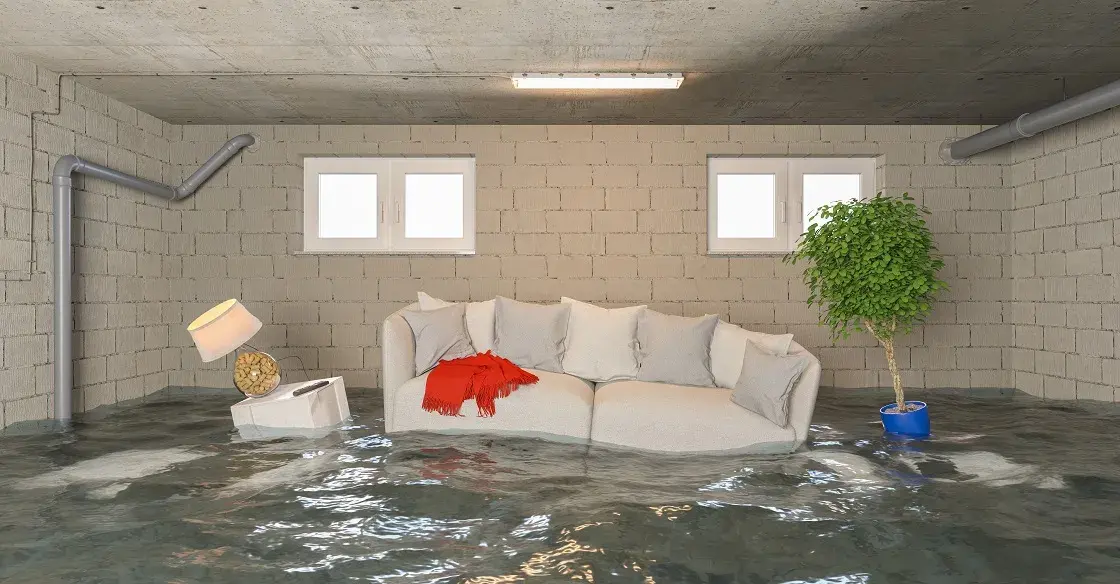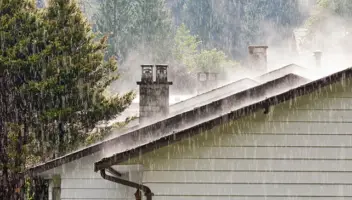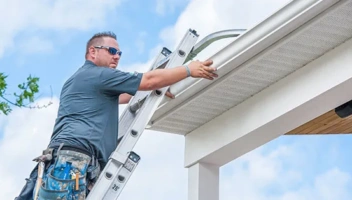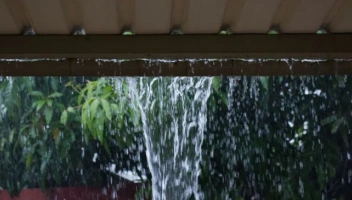What To Do When Your Basement Floods

A flooded basement is a nightmare for any homeowner, but knowing what to do when your basement floods can give you peace of mind in the event a water disaster occurs.
If your basement is damp, wet, littered with small puddles, or under an inch or two of standing water, you may be able to handle it yourself with a bit of time and effort.
However, should your basement be flooded with more than an inch or two of water, it’s best to call a professional who can treat the area effectively.
While knowing the cause of water in your basement is the first step in figuring out what to do, there are a number of safety precautions you should take before you go venturing into unknown waters.
Home water damage can include many dangers, from unsanitary water and bacteria to electrical sparks and fire hazards. Shut off all utilities, call the utility companies if necessary, and outfit yourself with protective gear before wading in to find the source of the problem.
In this article:
- Find the Source of the Problem
- The Causes of Basement Floods
- Water Damage Dangers
- Removing Standing Water
- Survey the Damage
- Prevent a Basement Flood
- Frequently Asked Questions
Find the Source of the Problem

You should only inspect your basement after you’ve taken all the necessary safety precautions, including shutting off the power. Start by looking for the immediate problem to address any ongoing leaks or incoming water.
Here’s what to do when your basement floods:
Take Safety Precautions
It can’t be stressed enough that you must take safety precautions when dealing with a flooded basement. Seeing water in your basement may be shocking or unsettling, but safety must come first, especially when mixing water, electricity, or gas lines.
Just because your basement appeared to flood because of heavy rain, it doesn’t mean that the water is as clean as rainwater. The water quality is questionable, and simple safety measures go a long way.
Steps you can take include:
- Contact utility companies
- Shut off electricity
- Turn off gas lines
- Wear rubber boots
- Use rubber gloves
- Protect your eyes and mouth
Inspect Your Basement
It may or may not be obvious where the water is coming in, but if it’s safe to do so, locate the problem so you can stop additional water from invading your basement. Check inside and out, pay attention to where the ground meets the foundation, and carefully look over the foundation walls for cracks or fissures.
Document any damage you notice along the way as you search for the main issue. Take photos for insurance purposes, and keep notes regarding your personal items.
The Causes of Basement Floods

Since there are a number of things that can lead to your basement taking on water, consider the following reasons when you look over your basement:
- Faulty plumbing connections
- Blocked drains
- Damaged appliance connections
- Malfunctioning sump pump
- Burst pipes
- Soil erosion
- Clogged gutters
- Sewage backup
- Cracked foundation
- Broken hot water heater
- Lack of basement waterproofing
Water Damage Dangers
When your basement floods, water damage begins immediately. Mold and mildew can begin to grow within 24 to 48 hours. And because basements are often the place to store hazardous materials, the risk of danger in your basement can be particularly high.
Water damage leads to other problems such as mold, electrical issues, wood rot, buckling floors, and a cracked foundation. Depending on the type of water—clean, gray, or black—bacterial growth from unsanitary water could lead to health problems.
When your basement floods, you may need to call in the professionals for basement mold removal. Water damage in the basement could also lead to necessary repairs to the floor, drywall, and ceiling, which may lead to first-floor repairs.
Removing Standing Water

Whether you’re waiting for a professional basement cleaner or not, removing standing water is an essential step in cleaning up your basement.
For several feet of water where the house’s structural integrity is compromised, FEMA recommends removing 1 foot of water every 24 hours to prevent the basement walls from collapsing due to a pressure change.
If you’re dealing with a couple of inches of water, there are a few tools that are handy to have around.
- Dehumidifier – A dehumidifier dries out the area it’s placed in. A dehumidifier is used after standing water is safely diverted away from your house; it removes excess moisture from the air and can help to dry out the basement.
- Sump pump – A sump pump can rid your basement of thousands of gallons of water if the electricity is running properly and it’s safe to use. You can also use gas-powered pumps if the electricity is off.
- Wet/dry vacuum – No home is complete without a wet/dry vacuum. Though they’re made for small amounts of liquids, a wet/dry vac can definitely help get the last of the standing water once the majority is removed through other means.
- Hoses – Use standard hoses and a siphon for funneling pooled water out of one area and into another. However, this method typically relies on gravity and could be difficult when working in a basement.
- Good, old-fashioned bucket brigade – Sometimes old-school methods work best. When all the utilities are off, you have no convenient back-up methods, and time is of the essence, a simple bucket or pail could be your best friend.
Survey the Damage
Once the standing water is removed, survey your basement closer, and continue to document damage and take photos for insurance purposes. Immediately remove all moveable items to ensure your belongings and the basement can adequately dry out, be treated, or repaired.
Then get a jump start on drying and cleaning your basement with fans, dehumidifiers, heating, or air conditioning.
Call a Professional
Cleaning and sanitizing a flooded basement can be a complex and time-consuming job, and thanks to the high risk of mold and mildew, it’s often best to call in a professional.
Restoration of a flooded basement requires multiple professions: a plumber for a burst pipe, an electrician to rewire the basement, water damage restoration professionals, HVAC technicians, and mold removal professionals.
Prevent a Basement Flood
Have you cleaned out your gutters yet? We didn't think so! Schedule your free estimate today and let our team do the rest by visiting https://t.co/4bLZOBDHja #LeafFilter #DebrisFree pic.twitter.com/wgfa3c90EW
— LeafFilter Gutter Protection (@LeafFilter) June 21, 2023
Learning what to do when your basement floods before standing water becomes a problem is your best course of action to prevent it from happening in the first place.
Fortunately, there are several things you can do to keep your basement nightmares from coming true.
- Consider a roof replacement – Inspect your roof and take care of any issues immediately. A damaged roof could cause a flooded basement.
- Upgrade gutters and downspouts – A clean gutter is a working gutter. If you’re not a fan of cleaning out your gutters, consider investing in gutter guards. Our award-winning LeafFilter gutter guard system is guaranteed to keep debris from clogging inside your gutters. Downspouts may also need to be cleaned out and extended so the water runs further away from the house.
- Waterproof your basement – From interior coatings and sealants you apply to foundation walls, to exterior drain systems and dry wells that collect water and divert it away, waterproofing your basement is a proactive step that can help prevent a basement flood.
- Install drip edges or drip paths – A drip edge encourages water runoff to drip off over the edge of the roof and not down the sides of your home. A drip path is a shallow, narrow dirt trench that usually features decorative stones or rocks, which is situated below and around the house to catch water that drips off the house, reducing the risk of puddles and standing water.
- Use rain chains – A rain chain hangs from the corners of the house. It’s a decorative chain featuring cups that fill with dripping water. As each cup fills, it spills to the next, and so down the chain to the ground below, where typically it drains into a dry well or something similar.
- Install indoor or outdoor drains – From French drains to simple swales, installing either indoor or outdoor, or both, drainage systems may be the best way to prevent a basement flood.
- Build a dry well or dry creek – A dry well or dry creek catches excess water and diverts it away from the house via underground pipes or other means, keeping it from pooling in your yard and potentially finding its way to your basement.
- Add a rain garden or retaining pond – Large-scale projects like rain gardens and retaining ponds add aesthetics to your yard while providing large areas that can hold more water in eco-friendly ways.
- Regrade your property – Regrade your property so it slopes away from your house, allowing water runoff to flow downhill naturally.
Waterproofing your basement is an ideal way to prevent a basement flood, and it’s best done before a basement is finished. The second best time is now.
LeafFilter gutter guards are an easy option to consider, providing a first line of defense against clogged gutters and the subsequent water damage they can cause. Having LeafFilter’s gutter guards professionally installed allows you to enjoy peace of mind knowing your gutters are clog-free.
Call us today at 1-800-290-6106 for a free quote and to learn more about how we can help protect your home from flooded basements and water damage.
Frequently Asked Questions
Will a flooded basement dry on its own?
A flooded basement requires immediate treatment to reduce the risk of water damage problems, especially those pertaining to your health. A flooded basement will not dry on its own and is at risk of being overrun with fungal growth and pest infestations.
Is it safe to live in a house with a flooded basement?
A flooded basement comes with a host of problems, from loss of property and possessions to the growth of mold and damage to the structural integrity of the house. A flooded basement should be taken care of as soon as possible.
What to do if you find water in your basement?
If you see water in your basement, take precautions with utilities and shut them off as needed. Attempt to find the source of the problem and remove the standing water. Remove items as necessary, increase air flow, and contact a professional basement cleaner.
How do I get water out of my basement fast?
Remove water from your basement with a sump pump, wet/dry vac, hose, dehumidifier, or with fans and heaters.


